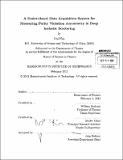A scaler-based data acquisition system for measuring parity violation asymmetry in deep inelastic scattering
Author(s)
Pan, Kai, Ph. D. Massachusetts Institute of Technology
DownloadFull printable version (9.425Mb)
Other Contributors
Massachusetts Institute of Technology. Department of Physics.
Advisor
William Bertozzi and Shalev Gilad.
Terms of use
Metadata
Show full item recordAbstract
An experiment that measured the parity violating (PV) asymmetry Ad in e- 2H deep inelastic scattering (DIS) at Q2 ~ 1.10 and 1.90 (GeV/c) 2 and XB ~ 0.3 was completed in experimental Hall A at the Thomas Jefferson National Accelerator Facility. The asymmetry can be used to extract the neutral weak coupling combination (2C2u-C2d), providing a factor of five to six improvement over the current world data. To achieve this precision, asymmetries of the 10- level needed to be measured at event rates up to 500 kHz with high electron detection efficiency and high pion background rejection capability. A specialized scaler-based counting data acquisition system (DAQ) with hardware-based particle identification was successfully implemented. The overall pion contamination in the electron sample was controlled to approximately 2 x 10-4 or lower with an electron efficiency above 91% throughout the experiment. The DAQ deadtime contributed an approximately 0.2% uncertainty to the final asymmetries. The statistical quality of the asymmetry measurement agreed with the Gaussian distribution to over five orders of magnitudes and the experimental goal of 3-4% statistical uncertainty was achieved. The results presented here demonstrate that this type of scaler-based DAQ is able to perform accurate measurements of small asymmetries at the 1ppm level. The design of the DAQ system is presented including the analysis of PID performance, deadtime effect and the capability of measuring small asymmetries.
Description
Thesis (S.M.)--Massachusetts Institute of Technology, Dept. of Physics, 2013. Cataloged from PDF version of thesis. Includes bibliographical references (pages 79-81).
Date issued
2013Department
Massachusetts Institute of Technology. Department of PhysicsPublisher
Massachusetts Institute of Technology
Keywords
Physics.